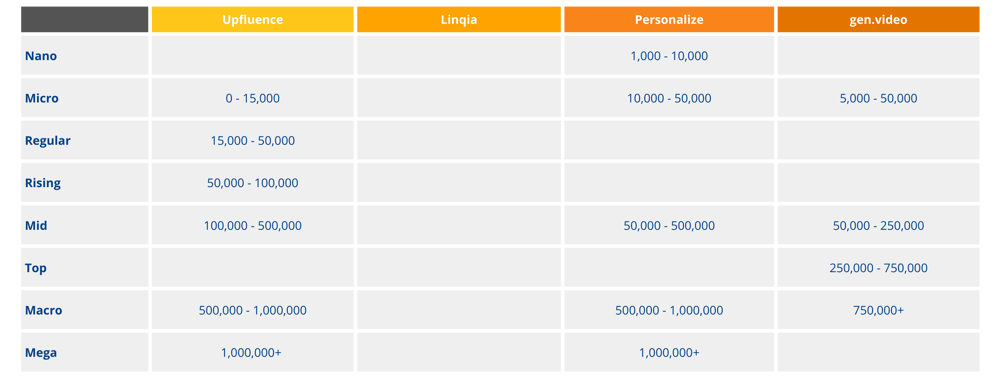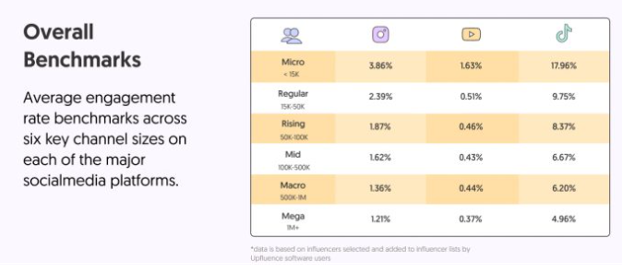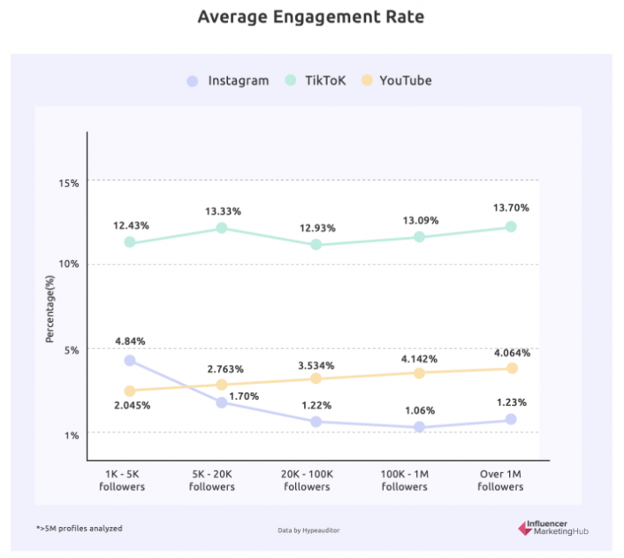Key Article Takeaways:
- Influencer tiers are generally similar, but can be slightly different depending on the influencer platform
- Engagement Rate benchmarks in the past solely showed Micro/Nano influencers as having superior performance
- When looking at benchmarks, it’s important to consider engagement rates based on views instead of subscriber counts.
- It’s going to be increasingly important to look past confirmation bias as data and trends change in the industry to know how to maximize ROI
- Macro tier influencers have several value factors that go beyond engagement rates and CTRs, namely ability to easily repurpose content
If you work in influencer marketing, you can’t miss all of the praise for micro and nano influencers. It’s so prevalent that you’d be forgiven if you thought there was some kind of law of physics that held that for every new subscriber gained, an influencer lost credibility and engagement. Now, if you’re like me and just reading that last sentence gave you pause (shouldn’t adding subscribers be evidence of growing influence?), well, this is the blog post for you!
Likewise, there’s so much talk about “nanos” “micros” and “macros” that one would assume that Google or maybe even the US Government’s Division of Weights and Measures had published some kind of standard guidelines. Nope again! The tiers have been created by influencer marketing platforms arbitrarily picking different cutoff points. For better or worse, we’ve sort of aligned on names for the tiers. So let’s start the math with a simple chart showing what at least few of us have put out there as truth:

OK, so now that the tiers are as clear as mud, let’s move on to the case for the superiority of nanos and micros. Where does that idea come from? As best I can tell, it all comes back to data that shows that they have more engaged audiences. Here’s a chart published in the Influencer Marketing Hub’s 2021 Industry Benchmark Report, which is similar to other analyses that proliferated for years:

This data is so neat and orderly that on its face, it screams out as credible. As we’ll find out in a minute, others are now coming out and saying, essentially, that this data is all wrong. Currently, we’re still living with the implications of these studies. Namely, the perception that nanos and micros are demonstrably superior.
What Went Wrong
For any detective looking at these Engagement Rate studies, there were definitely clues as to the challenges. The first was that as discussed in our Pricing Based on Reach post, Likes and Comments - in other words, engagement - have become a bit of a punchline as to what to not look at when judging the success of a campaign.
Yet here we were making judgments about strategy for the entire industry based on those exact metrics. And even if they were implying that earlier in an influencer’s career their subscriber base was more involved, by entirely divorcing the analysis from the costs of working with the influencers, we have no concept of the “cost” of the engagements or any other KPIs that we might be interested in.
Why did we get lured into this line of thinking? I think there were two dynamics at play:
- Confirmation Bias
- Self Interest
Confirmation Bias: Confirmation bias is the tendency to believe data that appears to support our existing beliefs and not only view it with less skepticism but to interpret it as proving our ideas. But why is the idea that nanos and micros are more effective so emotionally compelling that it leads to confirmation bias? I think it goes back to the core magic of influencer marketing itself: authenticity.
The perceived authenticity that influencers have with their audiences is believed to be one of the central drivers behind the rise of the influencer marketing industry. Where does this authenticity come from? It derives from the personal credibility of an individual who shares personal information with us: perhaps just their opinion on specific topics where they might be an expert (and so in that regard not so different from experts on TV or columnists in newspapers and magazines) but more frequently also including glimpses from other parts of their life.
Even if they stick closely to their area of expertise, because they are self-published on YouTube, Instagram or elsewhere, they are perceived differently from columnists even from reputable media outlets who we perceive as employees beholden to the media companies that employ them.
This idealistic view of an individual influencer creating content from their bedroom has - IMHO - become tangled up into a view that smaller influencers are more authentic than larger influencers.
Self-Interest: The other interpretation of buying so easily into these engagement reports is that these statistics create more business flow in the influencer world if a higher amount of cheaper, smaller Creators are onboarded for influencer programs.
The only thing I am sure of under that theory is that a brand will be chained to their influencer marketing strategies and the team handling influencer isn’t going to have enough time to consider alternatives. BTW, this is a good place to remind the reader that, as per usual in this series, I am focused on paid influencer strategies. If you are focused on influencer via gifting or affiliate fees only, in all likelihood you will be forced to focus on micros and nanos and do a lot lot LOT of manual work to continuously identify new influencers who are both willing to work that way and are effective.
Was there a different framework for thinking about influencer tiers and interpreting engagements (when measured as a percent of audience) data? Absolutely. Rather than thinking of the social media world as static, consider the implications of the reality that it is dynamic.
What Does That Mean?
It means that today’s micro influencer is tomorrow’s macro influencer. By definition, every macro was once a micro influencer. To think that an influencer’s ability to continue attracting new subscribers makes them less valuable is logically absurd. Their growth from micro to macro is not only proof of their influence but simultaneously disproves the theories (often presented as fact) that micros are the best place to find domain expertise (this would generally be in niches where the available audience is so small that it can’t support the general definition of macros).
The only theories that made any sense to explain diminishing engagement with increasing size were that perhaps as an audience grew (over time), part of the audience was becoming inactive and that by measuring against the overall subscriber bases (since almost no one unsubscribes from a channel), it made it look like engagement rates were falling. In fact, one could imagine this might indeed look like a law of nature…and present like the chart above.
The Data Has Turned, the Perception Hasn’t…Yet
Then a couple of months ago, Influencer Marketing Hub quietly put the following chart in their 2022 Benchmark Report, this time powered by data from HypeAuditor:

To be honest, I don’t think the IMH or HypeAuditor (or anyone else) realized what a bomb they dropped. HypeAuditor didn’t even include the chart in their own State of the Industry Report and if anything, IMH seems confused with quotes like, “TikTok now breaks the general rule of social media engagement. Large influencers have the highest engagement rate, while small influencers have the lowest” and “YouTube also breaks the general rule of social media, with larger YouTube channels having higher engagement rates than smaller channels.” OK, so if two of the three big platforms break the rule…is it a rule?
What I can’t find is any detail on the methodology here, but what I am guessing happened is that these are engagements against the posts views or impressions, not against the subscriber bases which was the methodological flaw as theorized above. In any event, HypeAuditor’s data is much more in line with gen.video’s own data which shows that post engagement rates and even more importantly, clickthrough rates are very consistent or even rise with influencer size as described in our 2021 Influencer Marketing and Social Commerce Report.
And so while maybe it’s me exhibiting Confirmation Bias and the next set of data is going to completely reverse course again, I’m willing to bet two things:
- Future data is going to further validate that there’s no rule that nanos and micros have more engaged or otherwise ‘better’ audiences and, if anything, the true ROI of working with these kinds of influencers can sometimes be lower.
- Perceptions and strategies will change a lot slower as we have a lot of emotion (& maybe a bit of self-interest) invested in the romance of the micro
So get ahead of the pack and make data-based decisions! Here is gen.video’s really simple framework for thinking about the size of influencers we want to work with:
- As long as an influencer has domain expertise in a vertical, the bias is bigger is better
- Not only is credibility higher within a subscriber base, but discoverability either via sharing or SEO is higher the larger the influencers, so the long term ripple effects are higher
- Beyond these two conscious biases, be guided solely by the actual metrics on cost per view, cost per click, conversion rate, repurposability of content and other
Finally, in the spirit of being guided by the data, would love to learn about other metrics or frameworks showing the value of nanos and micros. Or macros. Or any other kind of influencer.
